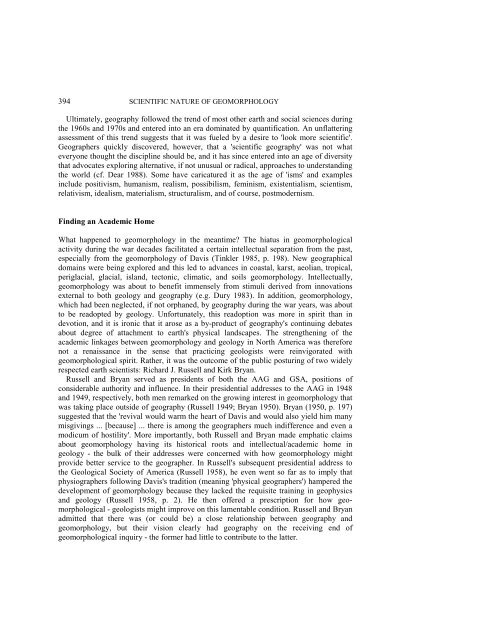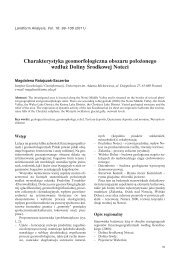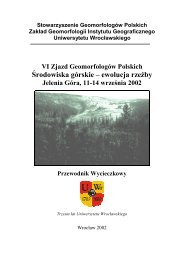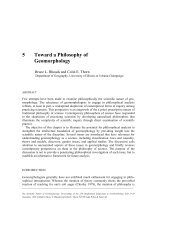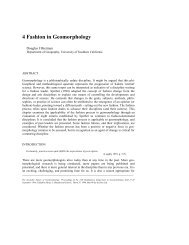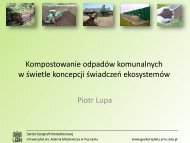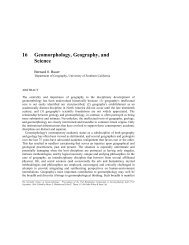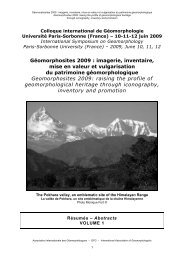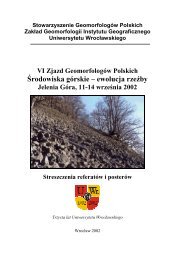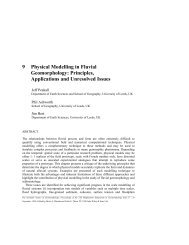Chapter 16 - Geomorphology, Geography, and Science Bernard 0
Chapter 16 - Geomorphology, Geography, and Science Bernard 0
Chapter 16 - Geomorphology, Geography, and Science Bernard 0
Create successful ePaper yourself
Turn your PDF publications into a flip-book with our unique Google optimized e-Paper software.
394 SCIENTIFIC NATURE OF GEOMORPHOLOGY<br />
Ultimately, geography followed the trend of most other earth <strong>and</strong> social sciences during<br />
the 1960s <strong>and</strong> 1970s <strong>and</strong> entered into an era dominated by quantification. An unflattering<br />
assessment of this trend suggests that it was fueled by a desire to 'look more scientific'.<br />
Geographers quickly discovered, however, that a 'scientific geography' was not what<br />
everyone thought the discipline should be, <strong>and</strong> it has since entered into an age of diversity<br />
that advocates exploring alternative, if not unusual or radical, approaches to underst<strong>and</strong>ing<br />
the world (cf. Dear 1988). Some have caricatured it as the age of 'isms' <strong>and</strong> examples<br />
include positivism, humanism, realism, possibilism, feminism, existentialism, scientism,<br />
relativism, idealism, materialism, structuralism, <strong>and</strong> of course, postmodernism.<br />
Finding an Academic Home<br />
What happened to geomorphology in the meantime? The hiatus in geomorphological<br />
activity during the war decades facilitated a certain intellectual separation from the past,<br />
especially from the geomorphology of Davis (Tinkler 1985, p. 198). New geographical<br />
domains were being explored <strong>and</strong> this led to advances in coastal, karst, aeolian, tropical,<br />
periglacial, glacial, isl<strong>and</strong>, tectonic, climatic, <strong>and</strong> soils geomorphology. Intellectually,<br />
geomorphology was about to benefit immensely from stimuli derived from innovations<br />
external to both geology <strong>and</strong> geography (e.g. Dury 1983). In addition, geomorphology,<br />
which had been neglected, if not orphaned, by geography during the war years, was about<br />
to be readopted by geology. Unfortunately, this readoption was more in spirit than in<br />
devotion, <strong>and</strong> it is ironic that it arose as a by-product of geography's continuing debates<br />
about degree of attachment to earth's physical l<strong>and</strong>scapes. The strengthening of the<br />
academic linkages between geomorphology <strong>and</strong> geology in North America was therefore<br />
not a renaissance in the sense that practicing geologists were reinvigorated with<br />
geomorphological spirit. Rather, it was the outcome of the public posturing of two widely<br />
respected earth scientists: Richard J. Russell <strong>and</strong> Kirk Bryan.<br />
Russell <strong>and</strong> Bryan served as presidents of both the AAG <strong>and</strong> GSA, positions of<br />
considerable authority <strong>and</strong> influence. In their presidential addresses to the AAG in 1948<br />
<strong>and</strong> 1949, respectively, both men remarked on the growing interest in geomorphology that<br />
was taking place outside of geography (Russell 1949; Bryan 1950). Bryan (1950, p. 197)<br />
suggested that the 'revival would warm the heart of Davis <strong>and</strong> would also yield him many<br />
misgivings ... [because] ... there is among the geographers much indifference <strong>and</strong> even a<br />
modicum of hostility'. More importantly, both Russell <strong>and</strong> Bryan made emphatic claims<br />
about geomorphology having its historical roots <strong>and</strong> intellectual/academic home in<br />
geology - the bulk of their addresses were concerned with how geomorphology might<br />
provide better service to the geographer. In Russell's subsequent presidential address to<br />
the Geological Society of America (Russell 1958), he even went so far as to imply that<br />
physiographers following Davis's tradition (meaning 'physical geographers') hampered the<br />
development of geomorphology because they lacked the requisite training in geophysics<br />
<strong>and</strong> geology (Russell 1958, p. 2). He then offered a prescription for how geomorphological<br />
- geologists might improve on this lamentable condition. Russell <strong>and</strong> Bryan<br />
admitted that there was (or could be) a close relationship between geography <strong>and</strong><br />
geomorphology, but their vision clearly had geography on the receiving end of<br />
geomorphological inquiry - the former had little to contribute to the latter.


